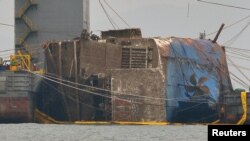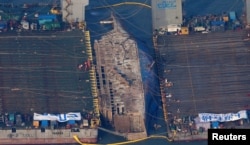South Korean efforts to bring a sunken, 6,800-ton ferry back to land cleared an obstacle Friday after divers cut off a vehicle ramp that had been dangling from the ship and hindering efforts to raise it.
Removing the ramp allowed workers to raise the ferry to a height where it can be loaded onto a semi-submersible transport vessel for transportation to a port.
More than 300 people, most of whom were students on a high school trip, died when the Sewol sank April 16, 2014, touching off an outpouring of national grief and soul searching about long-ignored public safety and regulatory failures. Public outrage over what was seen as a botched rescue job by the government contributed to the recent ouster of Park Geun-hye as president.
Ferry to be loaded on transport
Salvage crews raised the Sewol until its upper side was about 13 meters (42 feet) above the water's surface so that they could load it onto the transport vessel about two miles away.
Workers plan to complete loading the ferry by midnight Friday. The waters where the ferry sank are notorious for dangerous currents. The sea is relatively calm now, but currents are forecast to strengthen Saturday.
Workers on two barges began the salvaging operation Wednesday night, rolling up 66 cables connected to a frame of metal beams divers spent months placing beneath the ferry.
The bodies of 295 passengers were recovered after the sinking, but nine are still missing. Relatives, some of whom were watching from two fishing boats just outside the operation area, hope those remains will be found inside the ferry. Some cried as they watched the emerging wreckage with telescopes.
Relatives watching
“I shouted in joy when we heard that the ship surfaced at dawn. I thought we finally can find the missing nine,” Lee Geum-hee, the mother of a missing school girl, told a television crew.
“But when I actually saw the ship coming up, I was devastated. All this time my poor child was in that cold, dirty place. It was heart wrenching.”
Once the Sewol is loaded onto the transport vessel, it will take about two weeks for it to reach a port 90 kilometers (55 miles) away in the city of Mokpo.
Workers will then begin clearing mud and debris and search for the remains of the missing victims. An investigation committee will also search for clues that could further explain the cause of the sinking, which has been blamed on overloaded cargo, improper storage and other negligence.











